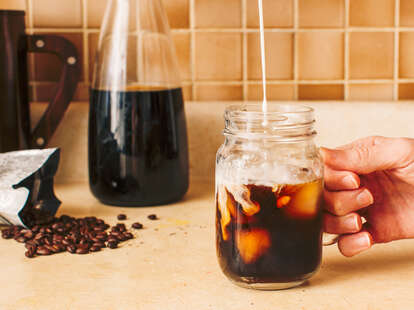
Photo by Cole Saladino for Thrillist
We are in peak cold brew season—when it’s so unfathomably hot that the thought of sipping on a steaming cup of coffee is the last thing on our minds. Instead, coffee drinkers are opting for strawfuls of smooth, creamy cold brew.
But on average, the cost of cold brew at your local coffee shop runs more than a dollar extra than the hot stuff. This is when you take matters into your own, under-caffeinated hands, decide to go Bob Villa barista-style, and brew batches of cold brew at home. We’re going to show you how to DIY from scratch and we’ll run through fancy-pants home brewing systems.
We’ve also included a quick cold brew primer, so you don’t sound like an idiot when you’re talking about your fancy new batches of cooled-down coffee. Look, for some strange reason, we just had a lot of extra energy today.
What is cold brew, really?
To put it bluntly, cold brew coffee is coffee that is brewed cold—or, at the very least, at room temperature—for about 12-24 hours, cut with water or milk (generally about a 50-50 ratio), and served cold, ideally on ice.
Wait, how is cold brew different from iced coffee?
In a way, cold brew coffee is iced coffee, in the sense that it’s coffee served cold. But, it’s not really a subset of iced coffee. Think of it more as iced coffee’s slightly more refined, more educated, worldly cousin that shows up at Thanksgiving dinner to make you feel bad about your own life.
It’s iced coffee that was always meant to be iced coffee. That’s the difference.
Traditionally, iced coffee is simply hot-brewed coffee that is allowed to cool and is served over ice. Cold brew is coffee that has been specifically engineered to be served cold. The colder brewing water and slower process gives it a silkier, less-acidic, less “watered-down” flavor than most “iced” coffees. Cold water doesn’t extract and break down the coffee beans’ natural components as well as hot water does. So, the result is often less bitter. Cold brew should be smoother in flavor profile, even though it looks pretty much the same as traditional iced coffee.
The brewing process takes about twice the amount of beans as brewing traditional coffee (because it’s a concentrate, designed to be “cut”). On that note, be warned: The concentrate (when not cut with other liquids) contains about twice the amount of the caffeine as regular coffee. Don’t forget to pare it down with milk or water.
What is New Orleans style cold brew?
New Orleans-style cold brew, traditionally, is regular cold brew that’s seeped with chicory in order to provide an extra kick of flavor. If you like the taste of chicory in your joe, you’ll like New Orleans-style.
Is Japanese iced coffee really cold brew coffee?
Eh, not really. Japanese iced coffee is probably better described as “flash-chilled” coffee than cold brew. Japanese iced coffee exchanges some water for ice during the brewing process, and takes way, way, way less time to make. If you want a true deep dive into the differences, and to be subtly coffee-shamed by some hardcore baristas, you can check out this piece on all things Japanese iced coffee.
You can buy cold brew at stores, right?
How to make cold brew at home
You can make cold brew at home with the use of one of these fancy machines we’ll tell you about below. But really, all you need is a Mason jar. And if you are under the age of 35 and/or planning a wedding, chances are you’ve probably got more than a few of those.
Step 1: You’re going to need beans that are as coarsely ground as possible. If the beans are too fine, there will be sludge and grime and all things unpleasant. The beans themselves are just a matter of preference (we have some great suggestions!), but again, you’ll probably want to grind them yourself to ensure they are as coarse as possible.
Step 2: Snag a large Mason jar (or really, any big, preferably glass container with a lid). You want about a 1:8 coffee-to-water ratio. Put your ground at the bottom of the container, and pour your water in. Cold water!
Step 3: Stir your concoction…gently.
Step 4: Cover, then place inside your fridge for 12-24 hours. You don’t have to put it in your fridge, but if you have one, you might as well.
Step 5: When it tastes like something you’d want to drink (not too strong, not too weak, Goldilocks stuff) strain it through a sieve, cheesecloth, or even a coffee filter to remove bigger clumps of grounds. Do this several times, till there’s no dusty residue on the bottom of your brew.
Step 6: Serve! Add whatever kind of milk you like. Drop in a dollop or two of sugar if you want. Pour over ice. You just made cold brew, kid!
You can! Just do the “plunge” at the end in lieu of straining. C’est si facile!
The best cold brew tools for your home
If you want the easy way out (which is actually fine here), there are now cold brew machines available that make it ridiculously easy for any idiot to bunker down and brew a fresh cup of cold brew coffee in the comfort of your home, office, or home that also doubles as an office.
Read more to see find out the best tools, machines, and supplies for cold brew success!